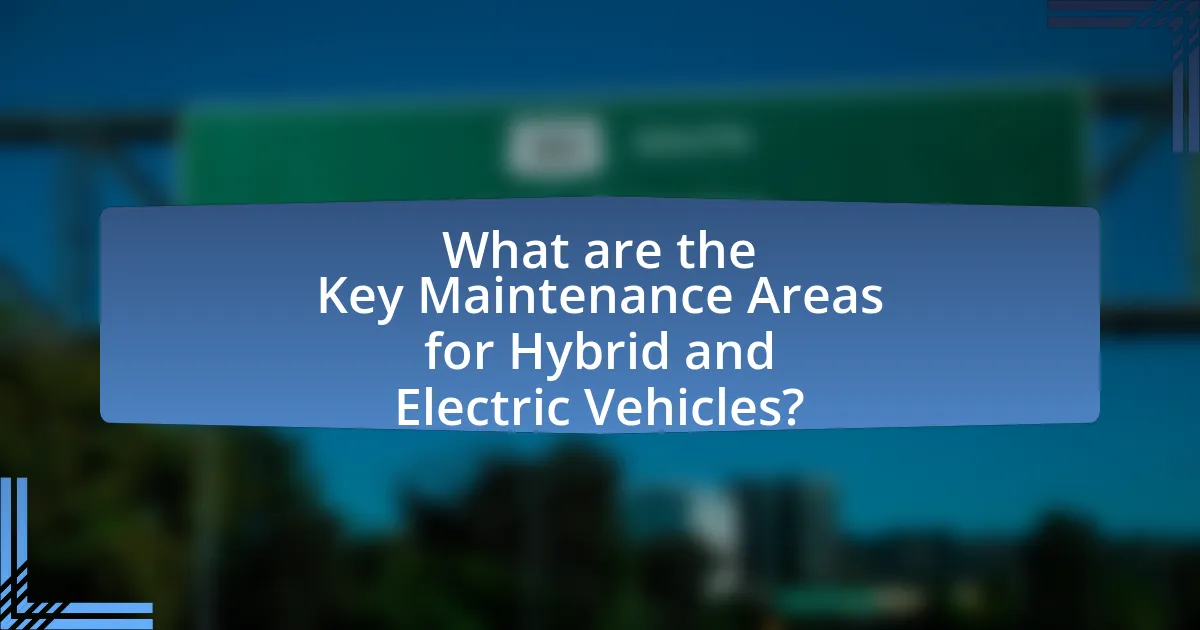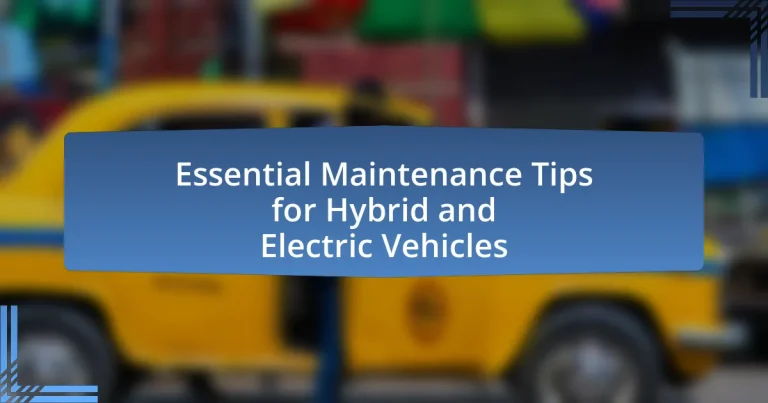The article focuses on essential maintenance tips for hybrid and electric vehicles, emphasizing the importance of regular battery checks, tire pressure maintenance, and brake system monitoring. It highlights the differences in maintenance requirements between hybrid/electric vehicles and traditional vehicles, noting that hybrids require more frequent servicing due to their combustion engines. Key components such as the battery pack, electric motor, and regenerative braking system are discussed, along with specific maintenance practices to enhance performance and longevity. The article also outlines the significance of adhering to maintenance schedules and the potential risks associated with neglecting upkeep, ultimately providing practical guidance for vehicle owners.

What are Essential Maintenance Tips for Hybrid and Electric Vehicles?
Essential maintenance tips for hybrid and electric vehicles include regularly checking and maintaining the battery, ensuring tire pressure is optimal, and monitoring brake systems. The battery, which is crucial for performance, should be inspected for any signs of wear or damage, as it can significantly affect range and efficiency. Maintaining proper tire pressure is vital for maximizing energy efficiency; under-inflated tires can lead to increased energy consumption. Additionally, hybrid and electric vehicles often utilize regenerative braking systems, which should be regularly checked to ensure they are functioning correctly, as they contribute to energy recovery and overall vehicle performance. Regular software updates are also important, as they can enhance vehicle efficiency and safety features.
How do hybrid and electric vehicles differ from traditional vehicles in terms of maintenance?
Hybrid and electric vehicles differ from traditional vehicles primarily in their maintenance requirements due to their distinct powertrains. Hybrid and electric vehicles typically require less frequent maintenance because they have fewer moving parts and do not rely on traditional combustion engines. For instance, electric vehicles do not require oil changes, and hybrids often have reduced brake wear due to regenerative braking systems, which can extend the lifespan of brake components. Additionally, the absence of exhaust systems in electric vehicles eliminates the need for related maintenance tasks. These differences lead to lower overall maintenance costs and less frequent service intervals compared to traditional vehicles, which require regular oil changes, exhaust system checks, and more extensive engine maintenance.
What unique components require special attention in hybrid and electric vehicles?
Hybrid and electric vehicles require special attention to components such as the battery pack, electric motor, regenerative braking system, and power electronics. The battery pack, which stores energy for propulsion, is critical as it can degrade over time, affecting performance and range. Electric motors, responsible for driving the vehicle, require maintenance to ensure efficiency and longevity. The regenerative braking system, which recovers energy during braking, needs inspection to maintain optimal functionality. Power electronics, including inverters and converters, manage the flow of electricity and require attention to prevent failures. Regular monitoring and maintenance of these components are essential for the reliability and efficiency of hybrid and electric vehicles.
How does the maintenance schedule differ for hybrid and electric vehicles?
The maintenance schedule for hybrid vehicles differs from that of electric vehicles primarily due to the presence of an internal combustion engine in hybrids. Hybrid vehicles require regular oil changes, air filter replacements, and maintenance of the engine components, typically every 5,000 to 10,000 miles, while electric vehicles, which do not have an engine, generally require less frequent maintenance, focusing mainly on battery health checks and tire rotations, often every 10,000 to 15,000 miles. This difference is supported by the fact that hybrids combine both electric and gasoline systems, necessitating a broader range of maintenance tasks compared to the simpler electric vehicle systems.
Why is regular maintenance crucial for hybrid and electric vehicles?
Regular maintenance is crucial for hybrid and electric vehicles to ensure optimal performance and longevity of their complex systems. These vehicles rely on both electric and combustion components, which require specific upkeep to function efficiently. For instance, battery health is vital; studies show that regular checks can extend battery life by up to 30%. Additionally, maintaining the electric motor and regenerative braking systems is essential for maximizing energy efficiency and minimizing wear. Neglecting maintenance can lead to decreased performance, increased repair costs, and reduced vehicle lifespan.
What are the potential risks of neglecting maintenance in these vehicles?
Neglecting maintenance in hybrid and electric vehicles can lead to significant risks, including reduced performance, safety hazards, and increased repair costs. For instance, failing to maintain the battery system can result in diminished battery life and efficiency, which may lead to unexpected breakdowns. Additionally, neglecting tire maintenance can cause uneven wear, affecting handling and safety. According to a study by the National Highway Traffic Safety Administration, improper maintenance is a leading cause of vehicle accidents, highlighting the critical importance of regular upkeep.
How can regular maintenance improve the lifespan of hybrid and electric vehicles?
Regular maintenance significantly improves the lifespan of hybrid and electric vehicles by ensuring optimal performance and preventing costly repairs. Routine checks on battery health, tire pressure, and fluid levels help maintain efficiency and safety. For instance, the U.S. Department of Energy states that proper battery maintenance can extend battery life by up to 30%. Additionally, regular inspections can identify issues early, reducing the risk of major failures that could lead to expensive replacements. Overall, consistent maintenance practices directly correlate with enhanced vehicle longevity and reliability.

What are the Key Maintenance Areas for Hybrid and Electric Vehicles?
The key maintenance areas for hybrid and electric vehicles include battery health, electric motor functionality, brake system maintenance, and tire condition. Battery health is crucial as it directly affects the vehicle’s range and performance; regular checks can prevent costly replacements. Electric motor functionality should be monitored to ensure efficient operation, as issues can lead to reduced power and efficiency. The brake system requires attention due to the regenerative braking feature, which can wear components differently than traditional brakes. Lastly, tire condition is important for safety and efficiency, as improper tire pressure can impact range and handling. Regular maintenance in these areas ensures optimal performance and longevity of hybrid and electric vehicles.
How should the battery system be maintained in hybrid and electric vehicles?
The battery system in hybrid and electric vehicles should be maintained by regularly monitoring its state of charge, ensuring proper temperature regulation, and performing periodic inspections for any signs of wear or damage. Regularly checking the state of charge helps prevent deep discharging, which can significantly reduce battery lifespan. Maintaining optimal temperature is crucial, as extreme heat or cold can adversely affect battery performance; manufacturers often recommend keeping the battery within a specific temperature range. Additionally, periodic inspections can identify issues such as corrosion or loose connections, which can lead to performance degradation. Following these maintenance practices can enhance battery longevity and efficiency, as supported by studies indicating that proper care can extend battery life by up to 30%.
What are the signs of battery wear or failure?
The signs of battery wear or failure include a significant decrease in driving range, slower charging times, and the presence of warning lights on the dashboard. A reduction in driving range indicates that the battery can no longer hold its full charge, which is a common symptom of wear. Slower charging times suggest that the battery’s internal chemistry is degrading, leading to inefficient energy storage. Additionally, warning lights, such as a battery icon or a check engine light, can signal potential issues with the battery’s health. These indicators are crucial for maintaining the performance and longevity of hybrid and electric vehicles.
How can battery performance be optimized through maintenance?
Battery performance can be optimized through maintenance by regularly monitoring and managing charge cycles, temperature, and physical condition. Properly maintaining charge cycles involves avoiding deep discharges and keeping the battery between 20% and 80% charge, which can extend its lifespan and efficiency. Additionally, maintaining an optimal temperature range, typically between 20°C and 25°C, prevents overheating and degradation of battery materials. Regularly inspecting the battery for physical damage, corrosion, or loose connections ensures that the battery operates effectively and safely. Studies indicate that following these maintenance practices can significantly enhance battery longevity and performance, with some research showing that proper charging habits can increase battery life by up to 30%.
What role does the electric motor play in vehicle maintenance?
The electric motor is crucial in vehicle maintenance as it directly influences the performance and efficiency of hybrid and electric vehicles. Regular maintenance of the electric motor ensures optimal functionality, which includes checking for wear and tear, ensuring proper lubrication, and monitoring electrical connections. According to the U.S. Department of Energy, electric motors in vehicles are designed to last for many years, but neglecting maintenance can lead to decreased efficiency and potential failures, impacting overall vehicle reliability.
How can you identify issues with the electric motor?
To identify issues with the electric motor, conduct visual inspections, listen for unusual noises, and monitor performance metrics. Visual inspections can reveal signs of wear, damage, or overheating, while unusual noises may indicate mechanical problems or bearing failures. Monitoring performance metrics, such as voltage and current readings, can help detect irregularities that suggest electrical issues or inefficiencies. Regular maintenance and diagnostic tools can further assist in pinpointing specific problems, ensuring the electric motor operates efficiently and reliably.
What maintenance practices can enhance electric motor efficiency?
Regular maintenance practices that can enhance electric motor efficiency include ensuring proper lubrication, maintaining clean electrical connections, and monitoring operating temperatures. Proper lubrication reduces friction, which can improve efficiency by up to 10%, while clean electrical connections prevent energy losses due to resistance. Additionally, monitoring operating temperatures helps to identify overheating issues that can lead to reduced performance and lifespan. These practices collectively contribute to optimal motor performance and energy efficiency.

What Specific Maintenance Tips Should Owners Follow?
Owners of hybrid and electric vehicles should follow specific maintenance tips to ensure optimal performance and longevity. Regularly check and maintain tire pressure, as proper inflation enhances efficiency and safety. Additionally, monitor the battery health by scheduling periodic inspections, as the battery is a critical component that can affect overall vehicle performance. Owners should also keep the vehicle’s software updated, as manufacturers often release updates that improve functionality and efficiency. Furthermore, routine inspections of the brake system are essential, as regenerative braking systems may require different maintenance compared to traditional brakes. Lastly, ensure that coolant levels for the battery and electric motor are within the recommended range to prevent overheating and maintain efficiency.
How can tire maintenance impact the performance of hybrid and electric vehicles?
Tire maintenance significantly impacts the performance of hybrid and electric vehicles by affecting energy efficiency, handling, and safety. Properly inflated and well-maintained tires reduce rolling resistance, which is crucial for maximizing the range of electric and hybrid vehicles. For instance, under-inflated tires can decrease fuel efficiency by up to 3% for every 1 PSI drop in pressure, as reported by the U.S. Department of Energy. Additionally, regular tire rotation and alignment ensure even wear, enhancing traction and stability, which is vital for the unique weight distribution of hybrid and electric vehicles. Therefore, maintaining optimal tire condition directly correlates with improved performance metrics such as range, handling, and overall safety.
What tire pressure levels should be maintained for optimal performance?
For optimal performance, tire pressure levels should be maintained between 30 to 35 PSI (pounds per square inch) for most hybrid and electric vehicles. Maintaining this pressure range ensures better fuel efficiency, improved handling, and enhanced tire longevity. According to the National Highway Traffic Safety Administration, properly inflated tires can improve fuel economy by up to 3% and reduce tire wear, which is crucial for the performance of hybrid and electric vehicles that rely on efficiency.
How often should tires be rotated or replaced in these vehicles?
Tires on hybrid and electric vehicles should be rotated every 5,000 to 7,500 miles and replaced every 25,000 to 50,000 miles, depending on driving conditions and tire type. Regular rotation helps ensure even wear, which is crucial for maintaining optimal performance and safety. According to the Tire Industry Association, proper maintenance can extend tire life and improve fuel efficiency, making adherence to these guidelines essential for vehicle longevity.
What are the best practices for maintaining the braking system in hybrid and electric vehicles?
The best practices for maintaining the braking system in hybrid and electric vehicles include regular inspection of brake pads and rotors, ensuring proper brake fluid levels, and utilizing regenerative braking systems effectively. Regular inspections help identify wear and tear, as hybrid and electric vehicles often use regenerative braking, which can extend the life of traditional brake components. Maintaining appropriate brake fluid levels is crucial, as low fluid can lead to brake failure. Additionally, understanding the vehicle’s braking system, including the integration of regenerative braking, allows for optimal performance and longevity of the braking system.
How does regenerative braking affect brake maintenance?
Regenerative braking significantly reduces the wear on traditional brake components, leading to less frequent brake maintenance. This system captures energy during braking and uses it to recharge the vehicle’s battery, which minimizes reliance on friction brakes. As a result, vehicles equipped with regenerative braking systems experience extended brake life, often requiring maintenance only after longer intervals compared to conventional braking systems. Studies indicate that regenerative braking can reduce brake pad wear by up to 70%, thereby decreasing the overall maintenance costs and frequency associated with brake servicing.
What indicators suggest that brake components need servicing?
Indicators that suggest brake components need servicing include unusual noises, such as squeaking or grinding, which indicate worn brake pads or damaged rotors. Additionally, a decrease in braking performance, such as longer stopping distances or a spongy brake pedal, signals potential issues with brake fluid or components. Warning lights on the dashboard, particularly the brake warning light, also indicate that servicing is necessary. Regular inspections can reveal physical signs like cracks or corrosion on brake components, further confirming the need for maintenance.
What common troubleshooting tips can help hybrid and electric vehicle owners?
Common troubleshooting tips for hybrid and electric vehicle owners include checking the battery charge level, ensuring proper connections, and monitoring warning lights on the dashboard. Battery charge levels can be verified through the vehicle’s display, which indicates if the battery needs recharging. Proper connections, especially for charging cables, should be inspected to ensure they are secure and free from damage. Additionally, monitoring warning lights can provide early indications of potential issues; for instance, a check engine light may signal a need for diagnostic evaluation. Regularly consulting the vehicle’s manual can also provide specific troubleshooting guidance tailored to the model.
How can you diagnose common issues in hybrid and electric vehicles?
To diagnose common issues in hybrid and electric vehicles, technicians utilize specialized diagnostic tools and software that interface with the vehicle’s onboard systems. These tools can read error codes from the vehicle’s control modules, allowing for the identification of specific faults related to the battery, electric motor, or hybrid system. For instance, the use of OBD-II scanners can reveal diagnostic trouble codes (DTCs) that indicate malfunctions, such as battery management system errors or electric drive issues. Additionally, visual inspections of components like wiring, connectors, and fuses can help identify physical damage or wear that may contribute to performance problems.
What resources are available for owners seeking maintenance guidance?
Owners seeking maintenance guidance for hybrid and electric vehicles can access several valuable resources. These include manufacturer websites, which often provide detailed maintenance schedules and guidelines specific to their models. Additionally, online forums and communities, such as those on Reddit or specialized automotive websites, allow owners to share experiences and advice. Furthermore, instructional videos on platforms like YouTube offer visual guidance on common maintenance tasks. Lastly, professional services, including certified dealerships and independent mechanics specializing in hybrid and electric vehicles, can provide expert advice and assistance.


